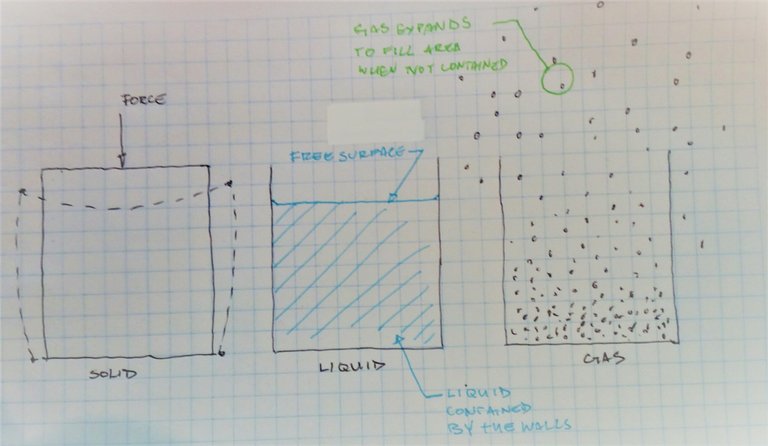Mechanics
In terms of mechanics matter is either a solid or a fluid (gas being a type of fluid) or exhibiting some measure of behavior of both states.

Difference Between Solids & Fluids
The mechanical difference between a solid and a fluid is the following:
A solid can resist a shear stress by a static deflection, a fluid can not.
That is to say, the result of the application of any shear stress (no matter how tiny) will be the movement of particles in that fluid. A ripple spreads out as the amplitude of its wave decreases with time, taking a long time to come back to rest.
It can be said that a fluid at rest, is in a state of zero shear, this is known as the hydro-static stress condition.
Difference Fluids & Gases
Fluids come in two basic varieties (we wont be discussing rheological or non-Newtonian fluids) liquids and gases.
Technically the differences is due to the cohesive forces of the experienced between the molecules of each type of matter. The closely packed molecules of liquids and strong cohesive forces allows the liquid to form a free definable surface, i.e. water stays in a cup does not fly out (bounded by its free surface) and expand to the size of the entire room. Gravitational forces govern the behavior of a particular liquids free surface.
Gases, on the other hand, expand if not contained and has no definite volume. Gases cannot from a free surface.
Velocity Field
The properties of a fluid in regard to its effect in space & time can be considered the solution of a fluid problem. This just means how is the fluid behaving in the x, y, z, direction with respect to time. In hydrodynamics we are not interested in tracking the movement of a particle in through fluid (Lagrangian concept), we are generally concerned with how the "flow field" behaves as it moves past a particular point, this is known as the Eulerian view of a fluid.
The major property of a fluid is its velocity (V) as a function of x, y, & z direction, or V(x, y, z,). The velocity is effectively the same as the solution to a flow field. Most of the future problems presented here will be in terms of finding solutions to fluid flow problems, that is the velocity in the space / time domain.
References
White, F., & Chul, R. Fluid mechanics (8th ed.). New York: McGraw Hill.

Congratulations @rezantroy! You received a personal award!
You can view your badges on your Steem Board and compare to others on the Steem Ranking
Vote for @Steemitboard as a witness to get one more award and increased upvotes!